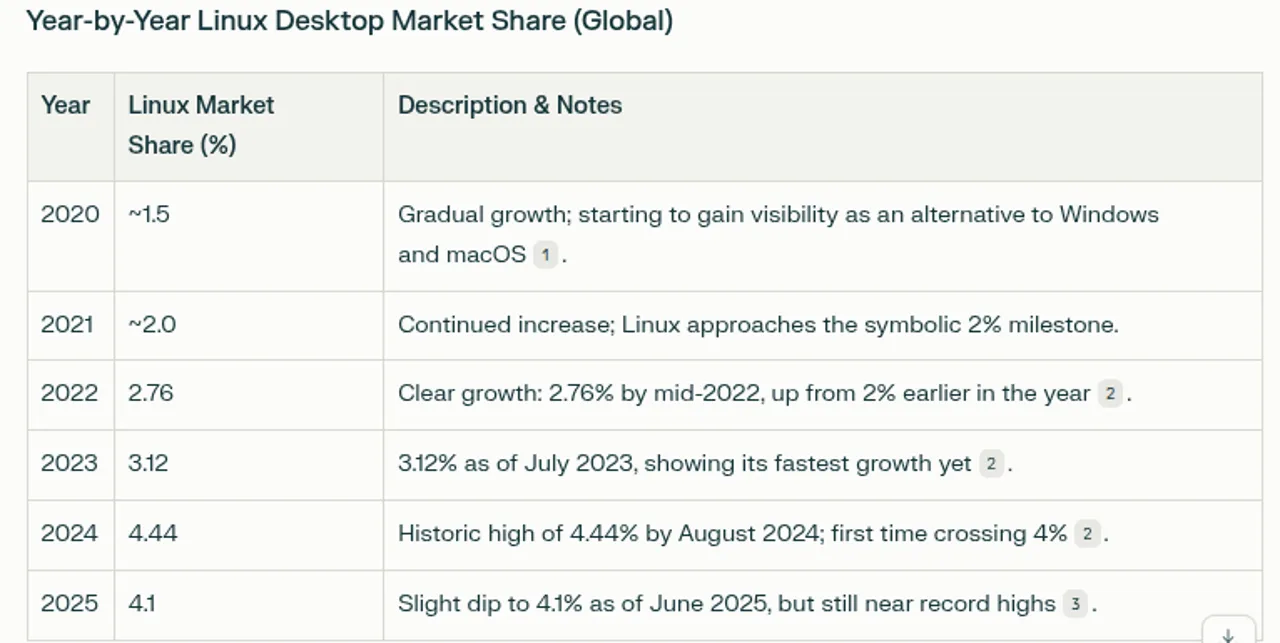- cross-posted to:
- linux@programming.dev
- cross-posted to:
- linux@programming.dev
Clickbaity title on the original article, but I think this is the most important point to consider from it:
After getting to 1% in approximately 2011, it took about a decade to double that to 2%. The jump from 2% to 3% took just over two years, and 3% to 4% took less than a year.
Get the picture? The Linux desktop is growing, and it’s growing fast.
Wow it was 5% yesterday
I read a similarly sensationalist headline with 4% two months ago and 5% yesterday. What’s up with the headline makers?
Linux is gaining market share quickly as the Windows 10 EOL rapidly approaches. There is still a massive amount of perfectly great hardware out there that isn’t officially supported by Windows 11, and only 3 months until Windows 10 reaches EOL.
According to more realistic data, e.g. https://gs.statcounter.com/os-market-share/desktop/worldwide/#monthly-202406-202506 the market share has been around 4% for the last year, even slightly declining in the meantime.
But that doesn’t make for nice, sensationalist headline stoked by wishful thinking.
Sorry to say, Linux isn’t going mainstream anytime soon and by and large the end of Win10 just means that the comparatively small group of users still running 5+ years old hardware will just buy a new PC or keep using their outdated OS.
In fact, if you combine the market share of outdated Windows versions (XP-8.1) you get a market share very close to the market share of Linux.
As much as we all would love it if the Linux market share goes to 50% in fall, it’s not going to happen.
The main issues with Linux adoption (it’s not preinstalled and most people have no idea which OS they are using and really can’t be bothered to reinstall) are just as present as they ware for the last 30 years.
All it takes is momentum. It’s a chicken-and-egg problem, and I think it’s gaining momentum because of Valve. Gaming was always the one thing stopping people from checking out Linux.
Now, however, more and more people are trying it out. More tech YouTubers are trying Linux, which means more exposure. Distros are becoming more refined. KDE is much better than it used to be because of Valve. All in all, there’s true momentum building.
In due time, Linux will be preinstalled on computers and laptops, and because of this, more people will contribute to Linux. People are fed up with the bloat and heavy AI push of Windows 11.
Bursting the Linux hype bubble on Lemmy, that’s courage!
Agreed. I think we’re still going to see a LOT of growth in Linux market share by the end of this year. I wouldn’t be surprised if it’s 7%-8% by then.
This. Personally, I’m scrambling to get all my shit sorted out on my desktop before switching over
Same here!
at this point linux will have more than 100% market share by next week!!!
They used a different data source for this one and mentioned why they preferred this one over the one from the day before.
So what you’re saying is that if we just keep switching to different data sources, we could get above 50% in less than two months!
Invest now!
And even at 50%, Nvidia still won’t release Linux drivers.
The avalanche has started. It is too late for the pebbles to vote.
Windows’ market share is being nibbled to death by cats.
Zathras, holding up a thumb drive with a Windows Installer ISO:
“No, never use this.”
New distro: ZathrOS
Error message: This why ZathrOS not have nice things.
Nah it’s just being replaced with phones.
Low tech users used to have cheap windows machines, now they have phones and tablets.
Exponential growth!
It makes perfect sense, the resistance of having Windows legacy software etc becomes smaller the more of that goes out of use, the resistance of everyone only knowing Windows becomes smaller with nobody even knowing Windows, and the resistance of corporate interests becomes smaller because it’s all in the Web, and the Web has been corrupted and Chrome works on Linux.
So. Listen to me carefully. If Linux domination happens without FreeBSD and Haiku normalization, then things are bad.
Curious about how popular enterprise/backend is.
Servers are like 90% Linux.
Linux is so much more stable than windows and its free+open source so everyone uses Linux on servers.
If you’re using the web, you’re being served by Linux. If you’re using a supercomputer, it’s running Linux. Etc, etc
Even when I’m ordering a pizza??
Yes ma’am/sir/pronoun of choice
I go by slice/pie. Thank for being polite.
But it is only in the US and not globally. Anyway, competition is good.
wtf I love Norway now? Sweden is at like 2%.
But Norway’s Linux spiked up to almost 30% in July 2024 as well. So I don’t really trust these sites. My guess is that it’s due to Tesla’s web browser or something? Tesla is the most popular electric car brand in Norway: 77k Model Y and 50k Model 3 are registered, and the only model with higher numbers is the Nissan Leaf with 81k, but that’ll be taken over very shortly (so far in 2025, there have been over 11k Model Y registrations, with the next runner-up being the Toyota BZ4X with 4,6k)
Possibly, but it does explicitly state desktop operating systems and I don’t know if Tesla’s would count towards that.
9% in India. But this is down from a peak of ~15% late last year when the govt was worried about US sanctions and was pushing for Linux adoption.
Why did go back to 9%? They all forgot about that theat or what?
-
There’s an uptick in ‘Unknown’ (currently at 26%).
-
Linux adoption might have slowed down because India - US relations have improved since then, because Trump can be distracted by promising him trade deals. Of course the deal he wants (giving US agri companies access to the Indian market) will face opposition from farmers’ unions, so I’m not sure what the govt’s long-term plan is.
One good thing is that when a govt dept switches to Linux, it sort of sticks. And govt contracts are very profitable, so we’ll likely see greater interest from both hardware and software companies.
-
Jumped to Bazzite never looked back. Let’s goooo
Most technology adoption follows an S curve, it can often take a long time to start to get going. Linux has gradually and steadily been improving especially for games and other desktop uses while at the same time Microsoft has been making Windows worse. I feel more that this is Microsoft’s fault, they have abandoned the development of desktop Windows and the advancement of support for modern processor designs and gaming hardware. This has for the first time has let Linux catch up and in many cases exceed Windows capabilities on especially gaming which has always been a stubborn issue. Its still a problem especially in hardware support for VR and other peripherals but its the sort of thing that might sort itself out once the user base grows and companies start producing software for Linux instead.
It might not be enough, but the switching off Windows 10 is causing a change which Microsoft might really regret in a few years.
Microsoft has been making Windows worse. I feel more that this is Microsoft’s fault, they have abandoned the development of desktop Windows and the advancement of support for modern processor designs and gaming hardware.
Moores law is dead since a long time except for graphic cards and GPUs. This means you can’t keep adding things to desktop software in the style of “What IBM giveth, Microsoft takes away”.
Existing development paradigms don’t add significant qualities to many-processor hardware.
Which also explains part of the AI craze. It is investment money searching for a sensible use.
The desktop has been Microsoft’s to lose for 30 years…
I’ll hang on to 10 as long as they’ll let me, but I am never going to 11. Then it’ll be a distro for dis bro.
Sorry.
Just curious and not judging your decision in anyway, but… “What are you waiting for?”
For me, VR support. Rocking win10 IOT LTSC on my main PC until compatibility improves, but already switched to Mint on my work laptop (and likely the main PC before/during 2032)
Awesome! Mint is great, it’s my number one recommendation.
I’ve never tried vr before and I’d really like to at some point.
OpenXR/SteamVR is an amazing system, and it’s easy to buy a second hand headset and just replace the face gasket (The Valve index has them attached with a few magnets). Especially with games like VRchat, Half Life ALYX, and modded support in games like Minecraft, PCVR is pretty good right now for newbies!
When it gets to 7%, is that when there is more malware designed for Linux desktop ?
Yeah, unfortunate to rain in the parade but GNU/Linux definitely needs some attention sooner rather than later. Plenty of design benefits, but also plenty of pitfalls from an OS sec POV.
Average users aren’t installing SELinux or Qubes so I hope no-one was actually going to reply with what Linux can do as opposed to the everyday user experience.
A few years outdated, but relevant: https://madaidans-insecurities.github.io/linux.html
but also plenty of pitfalls from an OS sec POV.
Can’t possibly be more vulnerable than Windows, the system where you can elevate yourself to highest privileges by simply clicking “Yes” on a prompt without a password, and where most users are running outdated versions of their software because they never update anything, or have a thousand background “updater” applets that are scheduled to run periodically and have the ability to install arbitrary executables from their servers.
If you run a repo-only system, where everything you install comes from the first-party distro repo, you’ll likely be fine. Just as you are on Windows or Android if you only download apps from the first-party store.
But like on Windows and Android, you’ll quickly reach the limit of what you can do with first-party store only.
Especially stuff like gaming requires non-repo/non-store stuff pretty quickly, and then you are on exactly the same turf as on Windows.
There’s no world where Windows users only use the official store. In fact, that’s why every “S” version of Windows always failed.
where everything you install comes from the first-party distro repo, you’ll likely be fine.
Canonical’s Snapcraft has a bad reputation for a reason. Many reasons. But compromised apps is a major one.
Can’t possibly be more vulnerable than Windows
The linked article provides many examples where security techniques lag far behind Windows. Vulnerability isn’t as simple as being ‘more vulnerable’ or ‘less vulnerable’, it’s a complex concept, and both GNU/Linux and Windows have design decisions which make each better than the other in various ways. We need to understand security in a more nuanced way than “x is better than y” if we actually want to protect ourselves from threats.
A Linux installation can be set to run root with no password or prompt. A Linux user can choose to never update their software - one could argue that Windows forced OS updates are an improvement here. The argument that the typical user has more technical understanding is a weak defense (as in, we really really really should not rely on that) and also irrelevant when we’re talking about Linux gaining a wider audience.
There is already plenty of malware targeting devs on Linux where is it’s strongest userbase.
Fuck man I saw a post in the past week that it was 5%. At this rate we’ll be leaving M$ in the du$t.
The 5% story was published yesterday. This new article from today says that they trust the government site figures more than StatCounter which was cited on yesterday’s story.
I thought the 5% story was for USA users
I’m not sure about the 5% story, but this 6% one is specifically about US government sites. Sorry I didn’t mention that in the post.
Hahaha so many articles on different percentages
I know! This article kind of addresses that with this line: “although we can’t be certain of the exact numbers, Linux is clearly growing”.
Interestingly enough, reading through again, the 6% figure is from US government sites, but the growth numbers in the line I quoted in the post is actually global. Here’s the graph they’re referring to:

I hadn’t noticed that dip in 2025 until I looked at this graph more closely!
Unfortunately the media failed to load
You mean the attachment in my comment above? It’s a webp file copied from the article, the table of year-by-year Linux desktop market share (global).

The key point is that Europe’s governments are ditching MS one by one. One of the state governments of India, that of Kerala, is also fostering a local chapter for open source and Linux.
That’s a thing, but the biggest thing is that PCs as a class have been falling in numbers. As media consumption devices, they’re outmoded. Phones, tablets, and cheap smart TVs have taken their place.
A typical family of 4 might have 1 laptop for when one is actually needed, whereas a few years ago every member of a suburban household would have their own computer.
So a larger part of the market is enthusiasts and techies, who are more likely to be using Linux, and gamers, who are using devices like the Steam Deck and Legion Go that run on SteamOS.
Been working with linux for the last 2 years. Had to use windows for my laptop for work but now its a full linux mint machine
After getting to 1% in approximately 2011, it took about a decade to double that to 2%. The jump from 2% to 3% took just over two years, and 3% to 4% took less than a year.
Could be exponential growth.
Exponential doesn’t mean fast.
That’s what I was wondering too. Doubling time halved already.
A king once summoned a wise man who had done him a great service and said, “Name your reward.” The wise man replied, “Your Majesty, I ask for a simple thing. Give me one percent Linux desktop market share for the first square of the chessboard, two percent for the second square, four percent for the third square, and so on, doubling the amount for each of the 64 squares.” The king, thinking this was a modest request, said, “Surely you jest! Such a small reward for such a great service? Ask for gold, land, or jewels instead.” But the wise man insisted, and the king agreed. The king ordered his treasurer to calculate the total. Starting with 1% for the first square, 2% for the second, 4% for the third, 8% for the fourth… by the time they reached the tenth square, they needed 512% of the desktop market. The treasurer, pale with realization, informed the king that by the 64th square, they would need more market share than could possibly exist in the entire universe of computing devices. The king then understood that what seemed like a humble request was actually impossible to fulfill, and he gained a new respect for the power of exponential growth.
It already goes over 100% market share after only 8 squares. 512% seems like a weird place to stop? How can you have more than 100% market share?
Better start populating some more planets. See you on Manjaro Delta Prime.
In the original it also supposedly amounts to more grain then there is in the kingdom.
Not supposedly, but mathematically. Even if the grateful king ruled the entire planet and the great warrior willing to settle for grains the size of a single atom, the king would be unable to pay in full; the total of grains on the whole chessboard would be 2^64 grains, but there are only 2^50 atoms on Earth.
Ooh, so I am thinking we make a black hole seeded with nothing but rice.
Theoretically you could make a black hole with a single grain of rice. You just have to figure out how to crush it down enough.
Obviously this is just more theory, but I think I’ve heard that the minimum size for a black hole is about on the order of a big mountain’s mass; something to do with the amount you can increase density before you’re actually forced to compress electron clouds down toward the proton.
I think that happens in any black hole formation. At least that’s my understanding of how neutron stars are formed. The electrons get forced into the nucleus and turn the protons into neutrons. From there it’s quark gluon plasma then a black hole.
In any case, I have no idea how either a grain of rice or a mountain could be made to do such a thing.
It also wouldn’t last very long due to Hawking radiation, but that’s another thing.
I went to CachyOS on my desktop full time this year. Already had Bazzite on a laptop.
There’s been a few hiccups here and there, but nothing insurmountable with a little patience and practice and reading.
And best part, those skills translate to most linux distros!












